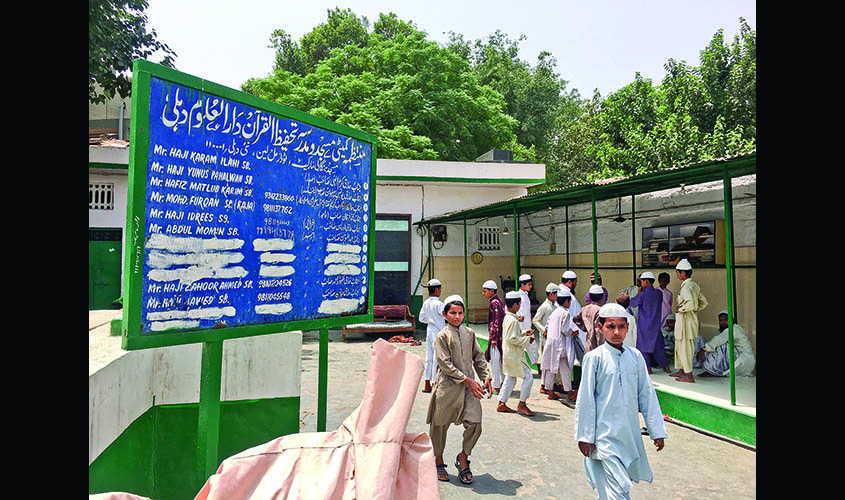Bridging the gap between religious education and “modern education”, madrasas in Delhi that are run by private committees are imparting basic modern education as part of their curriculum. What is interesting is the drastic increase in CBSE affiliated English-medium public schools which imbibe basic Islamic education as part of their school curriculum. While the CBSE schools that give both modern and basic Islamic education are popular among the Muslim middle class, madrasas continue to be the frontrunner among the economically backward Muslims. In a field survey of madrasas in Delhi, The Sunday Guardian took stock of the subjects taught in madrasas and the students who come to study there.
Clarifying the ambiguity around the term “college” in the name of her institution, Saima, principal of Zayed College for Girls, Okhla, said, “This is an only for girls madrasa. It was founded by the Sheikh Zayed foundation of the United Arab Emirates. At that time, it was identified as a college; so the term remained in its name. Now, we run this madrasa through funds and donations.”
The oriental building of Zayed College stands out among the unimpressive structures that surround it and is a home to approximately 400 girls who stay and study there. Including the day scholars, the total strength of the madrasa crosses 600. Boarding, lodging and education is free for girls in Zayed College, except the minimal amount of money that they have to pay for food provided in the mess. Saima said, “The subjects taught at Zayed College are Quran, Hadees, Tafseer, Arabic and Urdu language grammar, fiqah, English language, Maths, Science, Computer science and Hindi.” The girls wear traditional Indian women suits as uniform that includes the hijab. According to Saima, around 90% of the girls here come from poor families.
The minimum age for a girl to get admitted is 10 years, having cleared 7th standard exams. Education in Zayed College begins from the 8th standard and the certificate granted on completion of courses at Zayed College is recognised by Jamia Millia Islamia and the Aligarh Muslim University, being equivalent to 12th standard. “This allows the girls to pursue their higher education in various streams after they have completed their Islamic education here at Zayed. Some of our students have been selected in Tata Institute, IIM etc as well,” said Saima.
While Zayed College for Girls is among a handful of better-off madrasas, a small madrasa running within the Hyderabad House compound has to outsource the responsibility to impart modern English education to their 30 odd students. A committee member of Madrasa Zia-ul-Uloom run by Nizam Welfare Trust, Hyderabad House, who did not wish to be named, said, “We have hired a teacher who comes every day for three-four hours. He teaches our students English, Maths and Hindi subjects.” The masjid in Hyderabad House was established in 1941 and the madrasa was started in 1999. “Since 1999, the students here have studied both modern as well as Islamic subjects. All the 30 students live and eat here for free and do their own chores. All of them are boys who were sent here by their families because they could not afford their expenses and did not want them to fall in bad company,” said the Madrasa committee member.
Another madrasa near the popular Bengali Market, Barakhamba road, has appointed teachers who are well versed in Islamic as well as other modern subjects.
“Today students have their annual exam for English in the afternoon. We conduct exams twice a year for all our subjects. The total strength of our madrasa is 84,” said the caretaker of the Bengali market madrasa on the condition of anonymity.
In the different madrasas that this reporter visited, a majority of the students came from Uttar Pradesh, Haryana, Rajasthan and Bihar, apart from various other states. Basic English education was imparted in all of them, but the level of proficiency differed.
Emphasising on the structure of a madrasa, Mohammad Akhtar, an administrator and a teacher in a madrasa in Okhla said, “The priority of a madrasa is to create Islamic scholars who have in-depth knowledge of the Quran and the hadees. But we provide modern English education because students can choose to study other subjects in science, humanities and commerce for higher education once their Islamic education is completed in madrasa.”
But why does financially sound Muslim families don’t send their kids to acquire Islamic education in a Madrasa? Akhtar said, “There can be several reasons for this. Religious education does not the fulfill material needs of humans, which is why parents prioritise mainstream education over religion because that will help their children earn a better livelihood. Some families might not believe deen to be important enough to send their children to madrasa to understand it.”
Prioritising modern education over a religious one is seen as why the public schools that teach subjects like Urdu and Arabic language, Quran translations in English, importance of the five pillars of Islam and basic Islamic history are seen as a midway, but effective solution by most financially sound Muslim families living in an area like Okhla, whose character is predominantly Muslim.
“I have lived in Okhla for most of my life. In the past two decades, the landscape here has changed drastically in terms of availability of educational institutes. Today, there is a school in every fourth lane of Okhla. A rough estimate is that there are over 100 schools in Okhla, including its entire major localities like Ghaffar Manzil, Shaheen Bagh, Abul Fazal, Batla House, Zakir Nagar, Okhla vihar, Okhla gao etc. If you want your child to excel in Islamic knowledge, then you send them to a madrasa after they are 8-10 years old or if you want your child to excel in contemporary subjects but do not want them to be out of touch with their religion, then a public school that gives basic Islamic education is the solution,” explained Akhtar.

